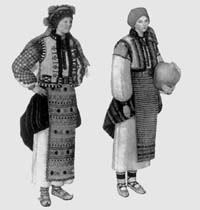From Commercial Interest to Private Collection

Words such as kraika, korzno, kliarma or yatl, once the language of learned ethnologists, are coming back today into the living language. This has been caused by the ever-growing interest in all things archaic.
Kyiv’s Rodovid gallery recently hosted an exhibition of plakhty, one of the oldest types of women’s dress. This kind of outdoor wear was most fashionable in the Middle Dnipro area (Chernihiv, Poltava, and Kyiv oblasts) and reached the peak of popularity in the times of Cossacks. Plakhty were only made by high-skilled weavers who made use of expensive woolen, silken, and flaxen fabrics. Unlike the zapaska (a piece of cloth that tightly hugs the body at the waist over an embroidered blouse), the plakhta was stitched up about half its length at one side, while a small frontal slit was adorned with an ornamented apron or belt. The color range depended on the wearer’s age and the garment’s purpose: scarlet and crimson plakhty were mostly worn by young women or on holidays, while women in their thirties as well as others on week days preferred more restrained hues. Plakhty designs and ornaments gave an impulse to the creation of interior-decoration textiles used for lining the walls or as bedspreads. As soon as mass-produced textiles emerged, the plakhty gave way to the skirt, a more comfortable garment to wear.
As part of the ‘Old Ukrainian Artifacts from Private Collections:’ series, initiated by the gallery, another event took place: the presentation of The Art of the Hutsul and Pokuttia Areas, the first book of the Rodovid publishing house, with illustrations provided by Lviv- based collector Taras Lozynsky. “Far from all of our neighbors want Ukrainians to live well, and I think they will be ‘planting’ their set values on us for many years to come. It is up to us to evaluate our heritage, and to decide who was a genius, who was mediocre and who was just a good Ukrainian. The system imposed on us by the Soviets put everything upside down: it made Ukrainian heroes out of mediocrities and enemies out of geniuses,” said Mr. Lozynsky, commenting on the campaign launched by Rodovid and other Ukrainian collectors. He also expressed the hope that this series, dedicated to folk craftsmen, would be followed by the publication of books on the creative work of little-known Ukrainian artists: while in Russia such publications sometimes run into several editions, in Ukraine they do not appear at all. According to art expert Volodymyr Rak, our neighbor already has a museum of private collections. Our collectors often cannot afford this luxury, while small private galleries can be counted on the fingers of one hand. Yet, there is a glimmer of hope. Mr. Rak noted that the surging interest in our own culture can also be illustrated by the fact that there already is a group of people ‘with money’ who go around villages collecting homemade icons and household items to be sold to collectors and, so to speak, amateurs. Moreover, guided not only by commercial interest, these buyers often manage to understand the artistic and historical value of such items and begin to glean them not for sales but for founding collections of their own.






